
BUSINESS
Kaiser Aluminum Corporation engages in manufacture and sale of semi-fabricated specialty aluminum mill products in the United States and internationally. The company offers rolled, extruded, and drawn aluminum products used for aerospace and defense, aluminum beverage and food packaging, automotive and general engineering products. The company’s automotive extrusions include extruded aluminum products for structural components, crash management systems, anti-lock braking systems, and drawn tubes for drive shafts, as well as offers fabrication services, including sawing and cutting to length.

INVESTMENT RATING

KALU is expected to be a Value Builder reflecting capital returns that are forecasted to be above the cost of capital.
Kaiser Aluminum has a current Value Trend Rating of C (Low Neutral).
With this rating, PTR’s two proprietary measures of a stock’s current attractiveness are providing consistent signals. Kaiser Aluminum has a neutral Appreciation Score of 56 and a slightly negative Power Rating of 35, triggering the Low Neutral Value Trend Rating.
Kaiser Aluminum’s stock is selling well below targeted value. The current stock price of $78.30 compares to targeted value 12 months forward of $100.
This neutral appreciation potential results in an appreciation score of 56 (44% of the universe has greater appreciation potential.)

Kaiser Aluminum has a Power Rating of 35. (This slightly negative Power Rating indicates that KALU’s chances of enjoying favorable investment performance over the near to intermediate term are only average.)
Factors contributing to this slightly negative Power Rating include: KALU’s earnings estimates have fallen very significantly in recent months; and recent price action has been slightly unfavorable. An offsetting factor is the Rolling & Drawing Nonferrous Metal comparison group is in a strong phase currently.
INVESTMENT PROFILE
KALU’s financial strength is low. Financial strength rating is 25.

Relative to the S&P 500 Composite, Kaiser Aluminum Corp has significant Value characteristics; its appeal is likely to be to investors heavily oriented toward Income; the perception is that KALU is extremely high risk. All factors are relative weaknesses. Relative weaknesses for KALU include: low forecasted profitability, low historical profitability, low financial strength, high stock price volatility, high financial leverage, low expected growth, low historical growth, and high earnings variability. KALU’s valuation is low: high dividend yield, moderate P/E ratio, and low price/book ratio. KALU has unusually low market capitalization.
CURRENT SIGNALS
Kaiser Aluminum’s current operations are eroding. Return on equity is falling, reflecting: declining pretax margin; and falling leverage.
Kaiser Aluminum’s current technical position is very strong. The stock price is in a 4.7 month up move. The stock has appreciated 44.2% from its prior low. The stock price is above its 200 day moving average which is in an uptrend.
ALERTS
Recent extremely meaningful positive changes in investment behavior have benefitted Kaiser Aluminum Corp (NASDAQ: KALU): the stock rose on very heavy volume, and positive upside/downside volume developed.
Recent notable negative changes in fundamentals have impacted Kaiser Aluminum Corp (NASDAQ: KALU): the consensus estimate for December, 2024 decreased significantly, significant quarterly earnings deceleration occurred, and the consensus estimate for December, 2025 decreased significantly.
The stock is currently rated C.
On 3/15/24, Kaiser Aluminum Corp (NASDAQ: KALU) stock increased 1.6%, closing at $78.30. Moreover, this advance was accompanied by exceptionally high trading volume at 735% of normal. Relative to the market the stock has been weak over the last nine months but has risen 3.7% during the last week.
CASH FLOW
In 2023, Kaiser Aluminum generated a very significant increase in cash of +$25.0 million (+44%). Sources of cash were much larger than uses. Cash generated from 2023 EBITDA totaled +$209.4 million. Non-operating sources contributed +$8.8 million (+4% of EBITDA). Cash taxes consumed -$0.1 million (0% of EBITDA). Re-investment in the business amounted to -$115.9 million (-55% of EBITDA). On a net basis, debt investors withdrew -$51.0 million (-24% of EBITDA) while equity investors pulled out -$26.2 million (-13% of EBITDA).
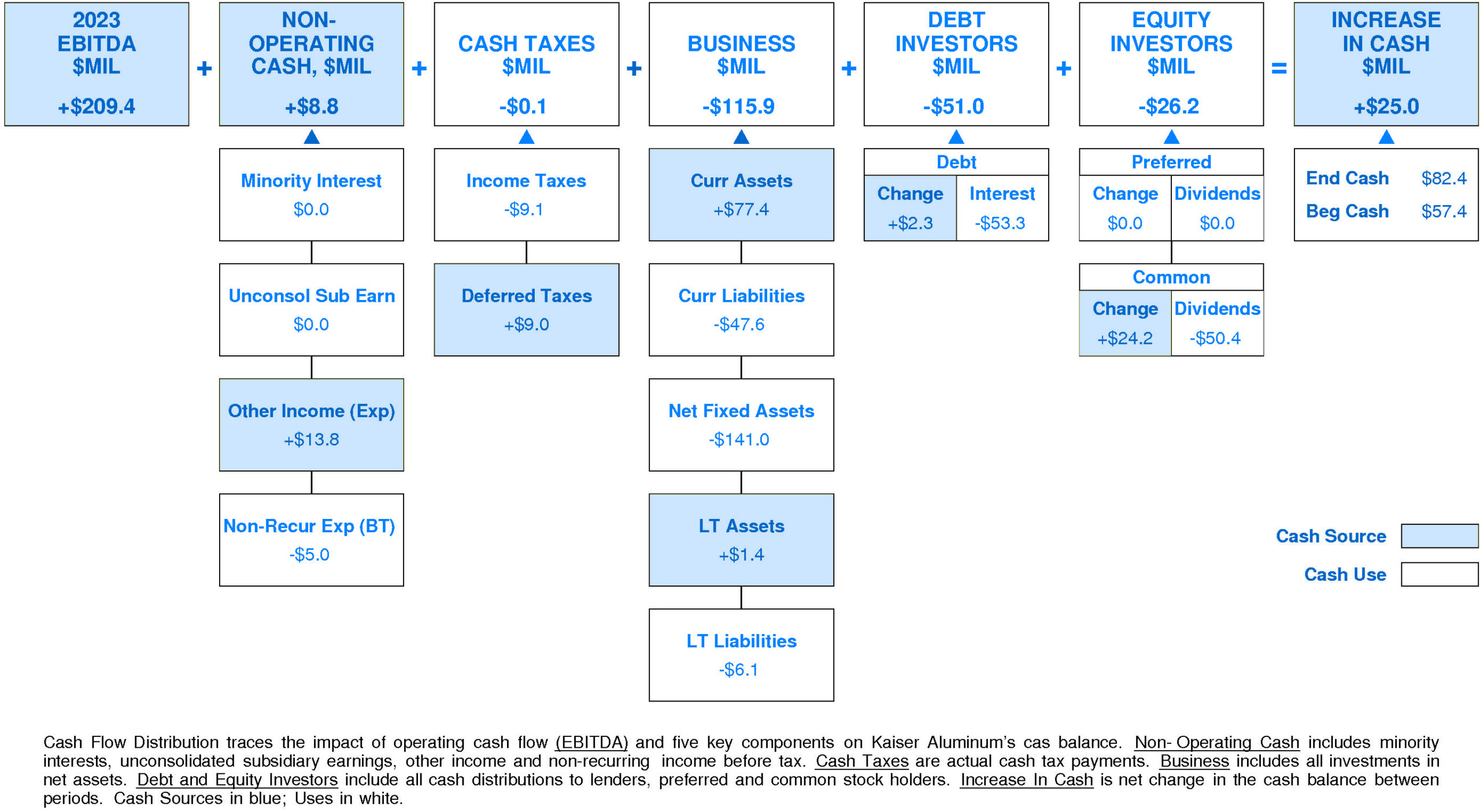
Kaiser Aluminum’s Non-operating Income, %EBITDA has enjoyed a volatile overall uptrend over the period. This improvement was accompanied by stability for the Kaiser Aluminum Peer Group. (Since 2021 Non-operating Income, %EBITDA has sharply accelerated.) In most years, Kaiser Aluminum was in the top quartile and lower quartile. Currently, Kaiser Aluminum is upper quartile at +4% of EBITDA (+$8.8 million).
Kaiser Aluminum’s Cash Taxes, %EBITDA has exhibited little to no overall change over the period. This stability was accompanied by an uptrend for the Kaiser Aluminum Peer Group. In most years, Kaiser Aluminum was in the top quartile and second quartile. Currently, Kaiser Aluminum is upper quartile at 0% of EBITDA (-$0.1 million).
Kaiser Aluminum’s Business Re-investment, %EBITDA has suffered a very strong overall downtrend over the period. This downtrend was accompanied by a similar trend for the Kaiser Aluminum Peer Group. (Since 2021 Business Re-investment, %EBITDA has experienced a very sharp recovery.) In most years, Kaiser Aluminum was in the third quartile and top quartile. Currently, Kaiser Aluminum is below median at -55% of EBITDA (-$115.9 million).
Kaiser Aluminum’s Debt Investors, %EBITDA has experienced a volatile overall uptrend over the period. This improvement was accompanied by an opposite trend for the Kaiser Aluminum Peer Group. In most years, Kaiser Aluminum was in the top quartile and lower quartile. Currently, Kaiser Aluminum is below median at -24% of EBITDA (-$51.0 million).
Kaiser Aluminum’s Equity Investors, %EBITDA has enjoyed a strong overall uptrend over the period. This improvement was accompanied by a similar trend for the Kaiser Aluminum Peer Group. In most years, Kaiser Aluminum was in the second quartile and lower quartile. Currently, Kaiser Aluminum is slightly above median at -13% of EBITDA (-$26.2 million).
Kaiser Aluminum’s Change in Cash, %EBITDA has experienced a volatile overall downtrend over the period. This downtrend was accompanied by stability for the Kaiser Aluminum Peer Group. (Since 2021 Change in Cash, %EBITDA has experienced a very sharp recovery.) In most years, Kaiser Aluminum was in the lower quartile and top quartile. Currently, Kaiser Aluminum is at the upper quartile at +12% of EBITDA (+$25.0 million).
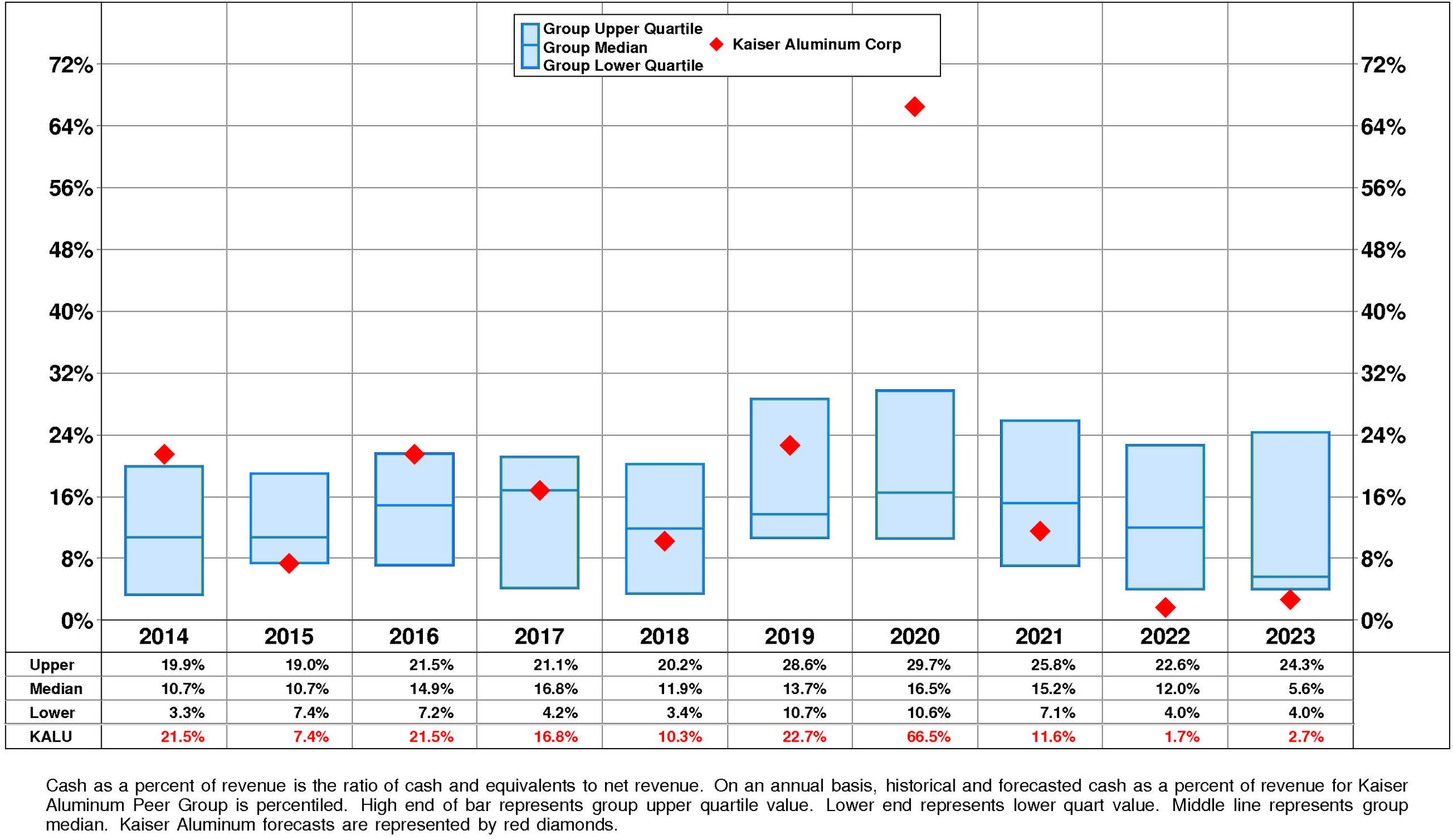
Kaiser Aluminum’s Cash, %Revenue has experienced a downtrend over the period. This downtrend was accompanied by stability for the Kaiser Aluminum Peer Group. In most years, Kaiser Aluminum was in the top quartile and third quartile. Currently, Kaiser Aluminum is lower quartile at +3%.
PROFITABILITY
Kaiser Aluminum’s return on equity has eroded very significantly since 2014. The current level is 7.2% versus the high of 7.1% and the low of -30.6%.
Kaiser Aluminum’s very strong negative trend in pretax operating return significantly offset by a very strong positive trend in non-operating factors is a major performance consideration.
The productivity of Kaiser Aluminum’s assets rose over the full period 2014-2023: asset turnover has enjoyed a very strong overall uptrend that accelerated very sharply after the 2020 level.
More than offsetting this trend, however, pretax margin experienced a strong overall downtrend although it experienced a very sharp recovery after the 2022 low.
Non-operating factors (income taxes and financial leverage) had a very significant positive influence on return on equity.
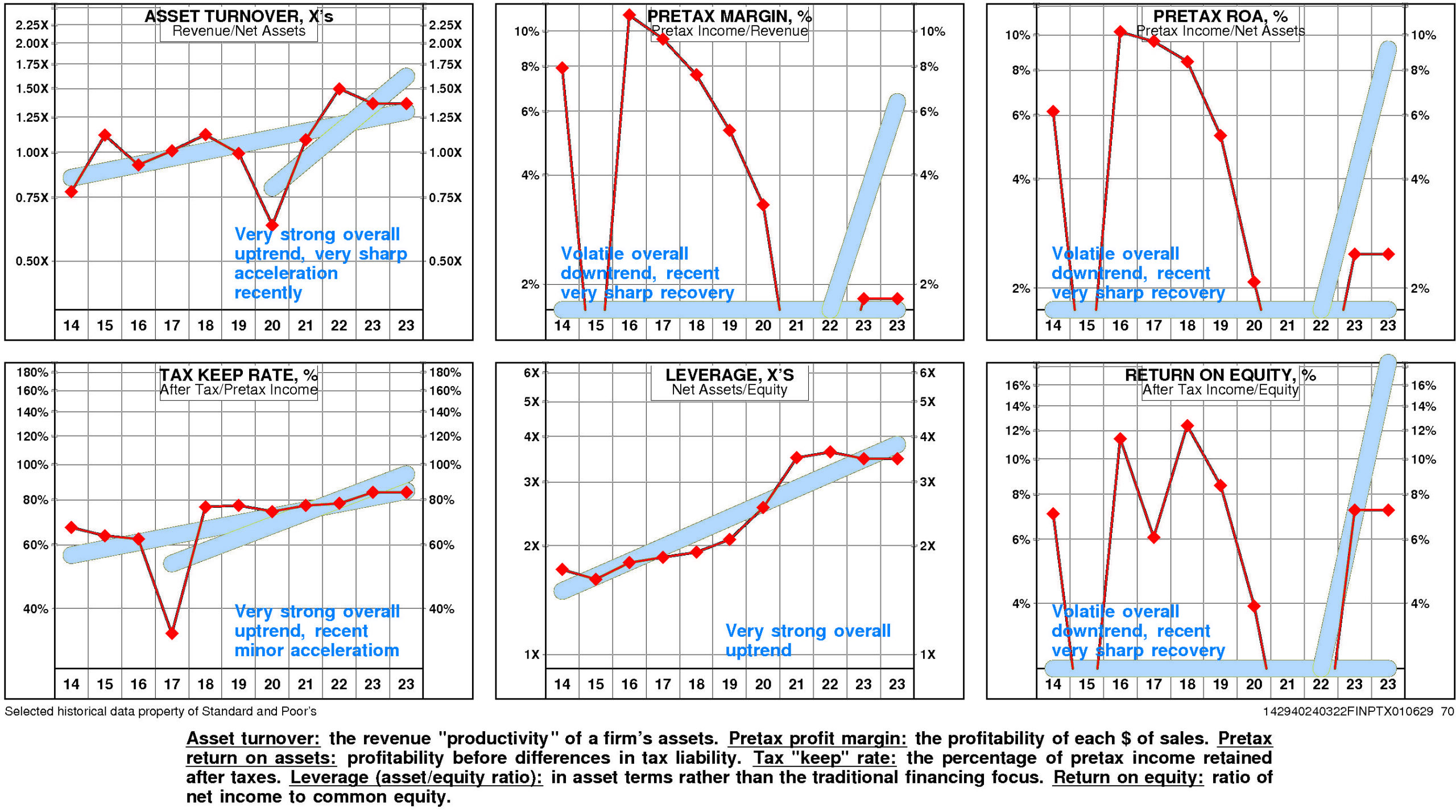
Kaiser Aluminum’s return on equity is at the lower quartile (7.2%) for the four quarters ended December, 2023.
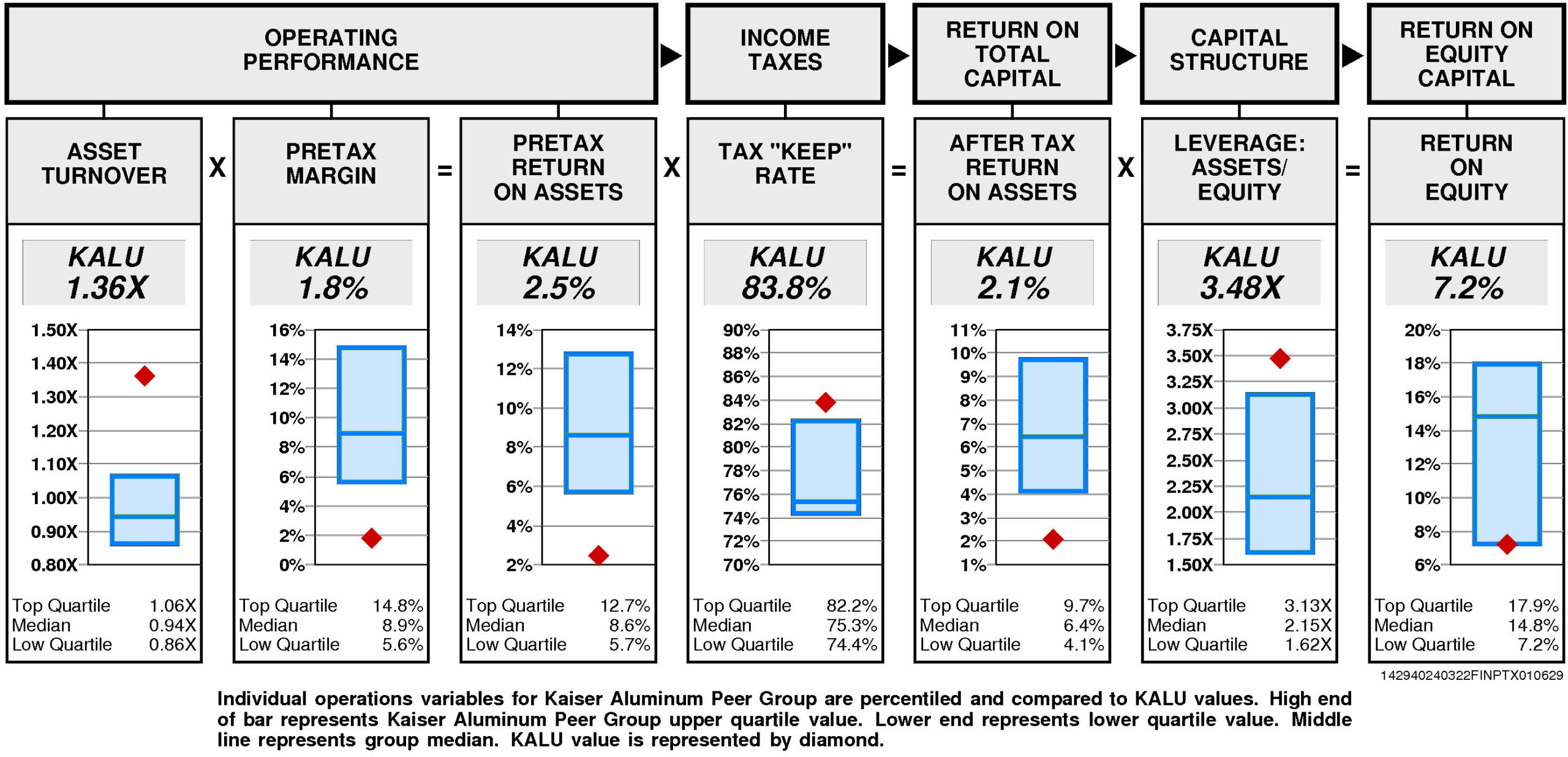
Operating performance (pretax return on assets) is lower quartile (2.5%) reflecting asset turnover that is upper quartile (1.36X) and lower quartile pretax margin (1.8%).
Tax “keep” rate (income tax management) is at the upper quartile (83.8%) resulting in after tax return on assets that is lower quartile.
Financial leverage (leverage) is upper quartile (3.48X).
GROWTH RATES
Overall, Kaiser Aluminum’s growth rate has slowed considerably in recent years.
Kaiser Aluminum’s historical income statement growth has been in line with balance sheet growth. Revenue growth has paralleled asset growth; earnings growth has paralleled equity growth.
Annual revenue growth has been 12.1% per year. (More recently it has been 23.2%.)
Total asset growth has been 7.5% per year. (More recently it has been -2.1%.)
Annual E.P.S. growth has been -3.5% per year.
Equity growth has been -2.1% per year.
No consensus growth rate forecast is available for Kaiser Aluminum.
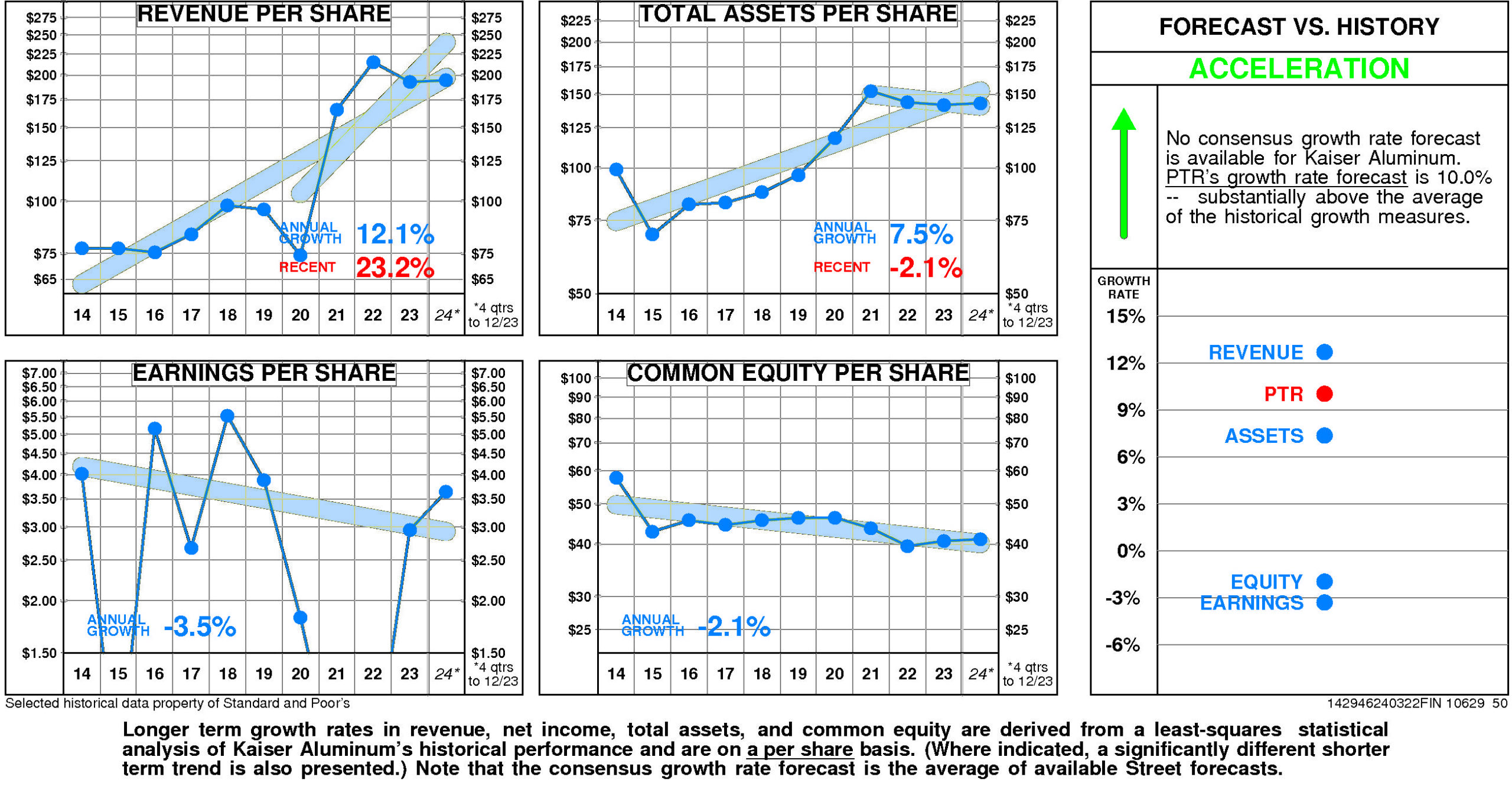
Relative to the Kaiser Aluminum Peer Group, Kaiser Aluminum’s historical growth measures are erratic. Revenue growth (12.1%) has been at the upper quartile. Total asset growth (7.5%) has been above median. E.P.S. growth (-3.5%) has been lower quartile. Equity growth (-2.1%) has been lower quartile.
Consensus growth forecast is unavailable.

PRICE HISTORY
Over the full time period, Kaiser Aluminum’s stock price performance has been variable and significantly below market. Between May, 2013 and March, 2024, Kaiser Aluminum’s stock price rose +23%; relative to the market, this was a -61% loss. Significant price moves during the period: 1) May, 2021 – September, 2022: -53%; 2) September, 2020 – May, 2021: +141%; and 3) December, 2019 – September, 2020: -52%.
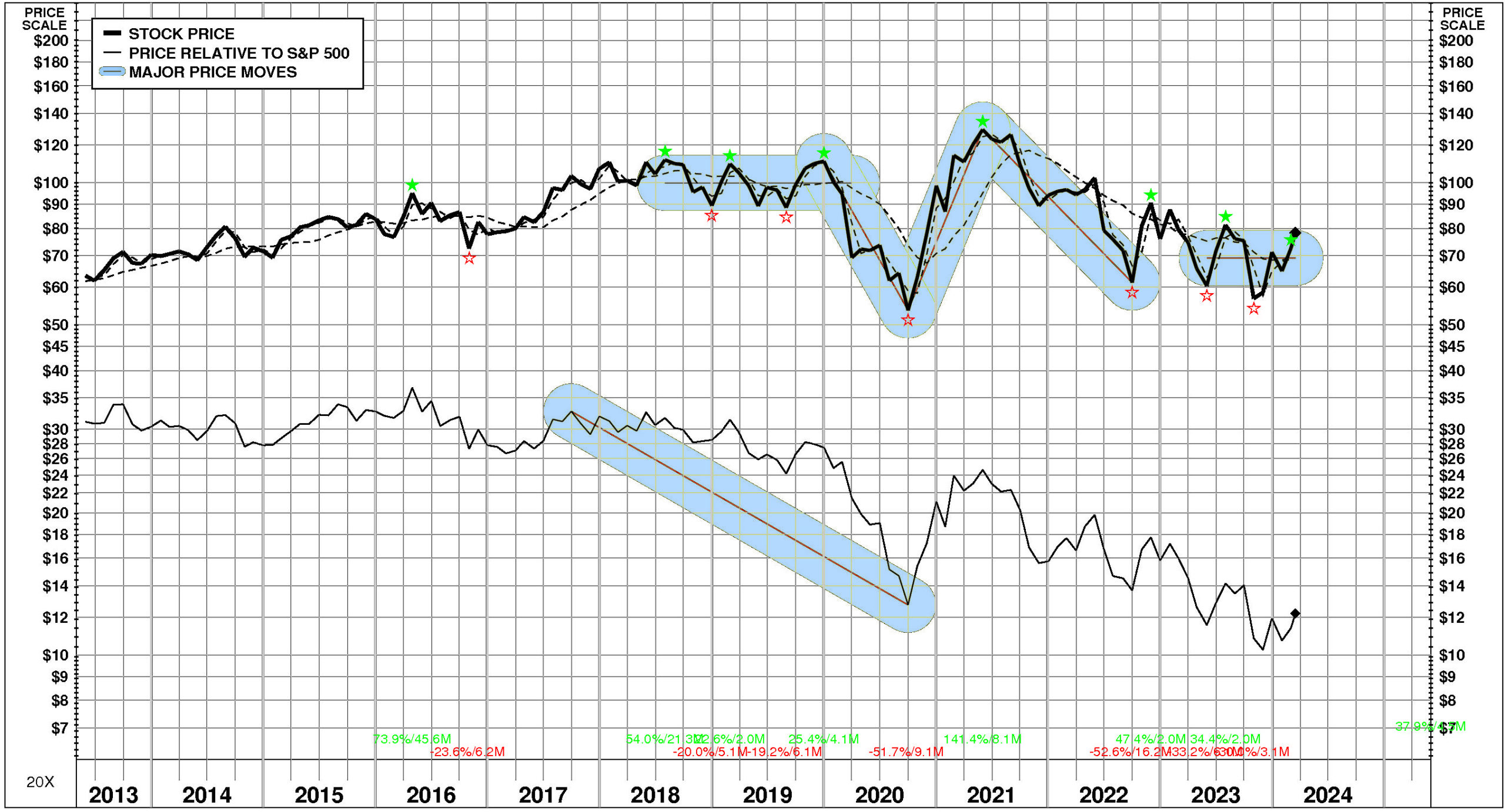
TOTAL INVESTMENT RETURNS
Current annual total return performance of -4.2% is substantially below median relative to the S&P 500 Composite.
In addition to being substantially below median relative to S&P 500 Composite, current annual total return performance through February, 2024 of -4.2% is below median relative to Kaiser Aluminum Corp Peer Group.
Current 5-year total return performance of -4.7% is lower quartile relative to the S&P 500 Composite.
Through February, 2024, with lower quartile current 5-year total return of -4.7% relative to S&P 500 Composite, Kaiser Aluminum’s total return performance is lower quartile relative to Kaiser Aluminum Corp Peer Group.
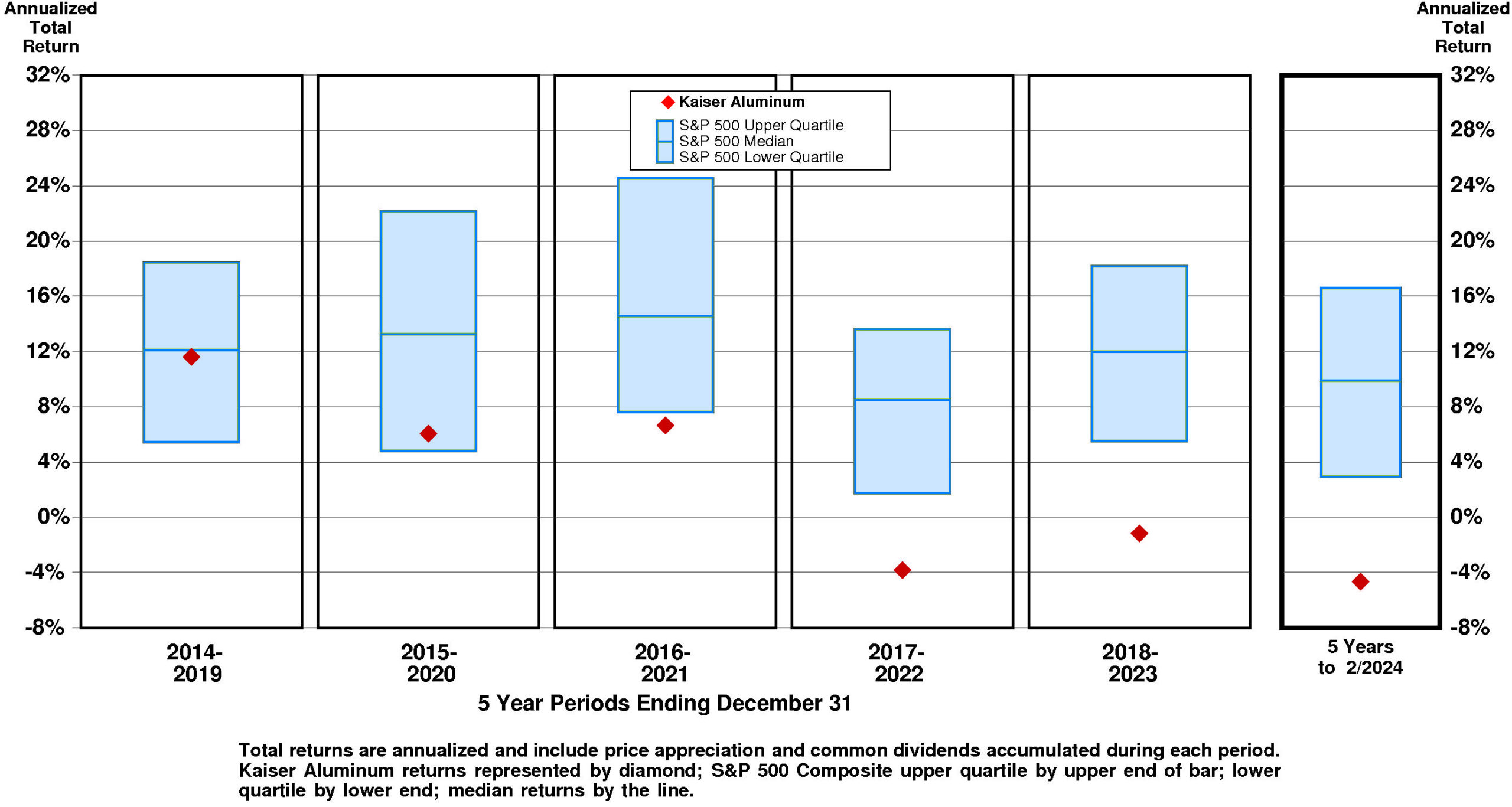
VALUATION BENCHMARKS
Relative to S&P 500 Composite, KALU’s overall valuation is normal. The highest factor, the price/earnings ratio, is above median. Ratio of enterprise value/earnings before interest and taxes is slightly above median. Ratio of enterprise value/assets is near the lower quartile. Price/equity ratio is near the lower quartile. The lowest factor, the ratio of enterprise value/revenue, is lower quartile.
Relative to Kaiser Aluminum Peer Group, KALU’s overall valuation is low. The highest factor, the ratio of enterprise value/earnings before interest and taxes, is above median. Price/earnings ratio is above median. Ratio of enterprise value/assets is lower quartile. Price/equity ratio is at the lower quartile. The lowest factor, the ratio of enterprise value/revenue, is lower quartile.
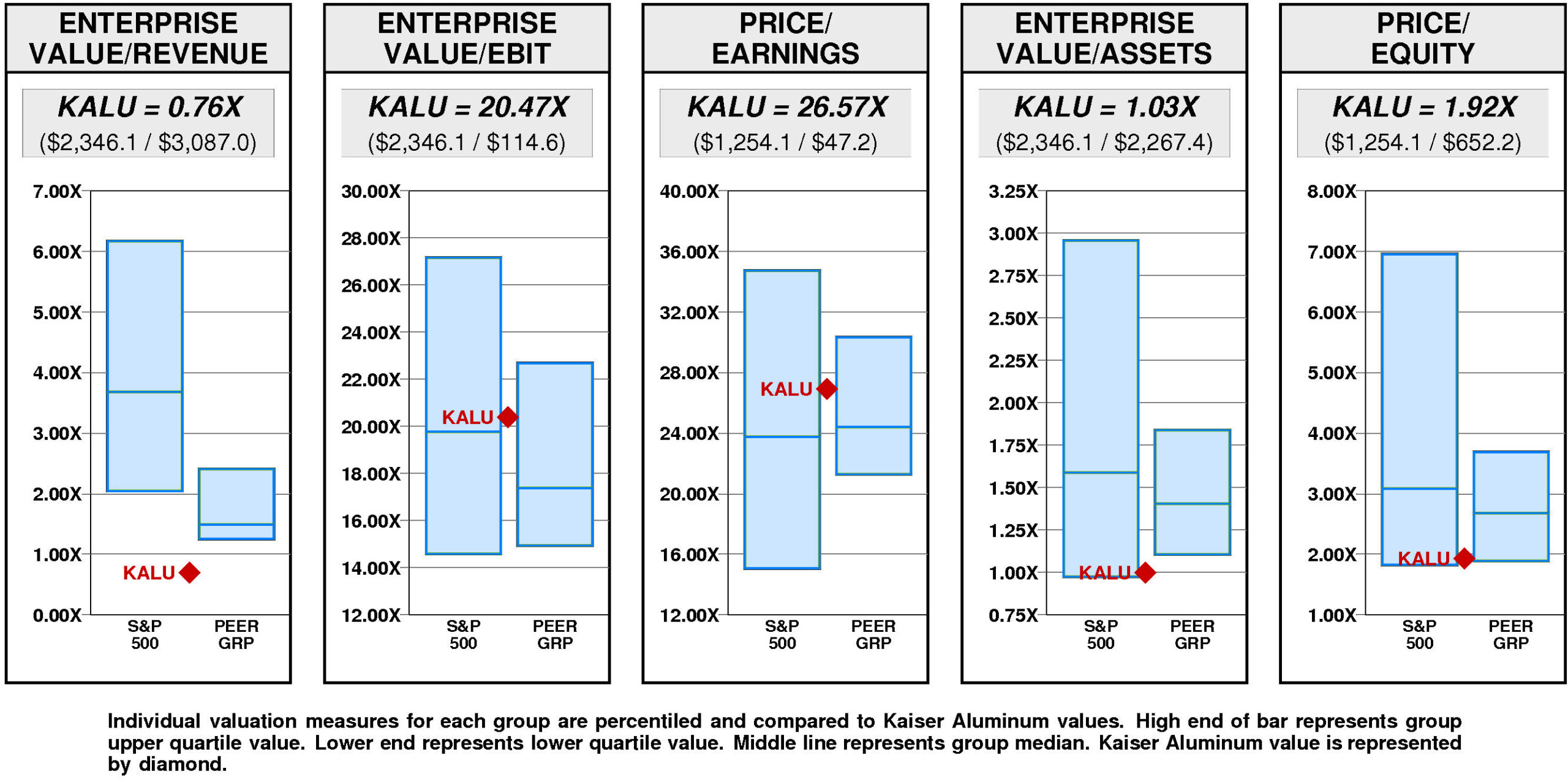
Kaiser Aluminum has a major value gap compared to the median. For KALU to hit median valuation, its current ratio of enterprise value/revenue would have to rise from the current level of 0.76X to 1.49X. If KALU’s ratio of enterprise value/revenue were to rise to 1.49X, its stock price would be higher by $141 to $219.
For KALU to achieve upper quartile valuation relative to the Kaiser Aluminum Peer Group, its current ratio of enterprise value/revenue would have to rise from the current level of 0.76X to 2.41X. If KALU’s ratio of enterprise value/revenue were to rise to 2.41X, its stock price would increase by $318 from the current level of $78.
VALUE TARGETS
KALU is expected to be a Value Builder reflecting capital returns that are forecasted to be above the cost of capital.
Kaiser Aluminum’s current Price Target of $117 represents a +50% change from the current price of $78.30.
This neutral appreciation potential results in an appreciation score of 56 (44% of the universe has greater appreciation potential.)
Reinforcing this neutral Appreciation Score of 56, the moderately low Power Rating of 35 contributes to an Value Trend Rating of C.
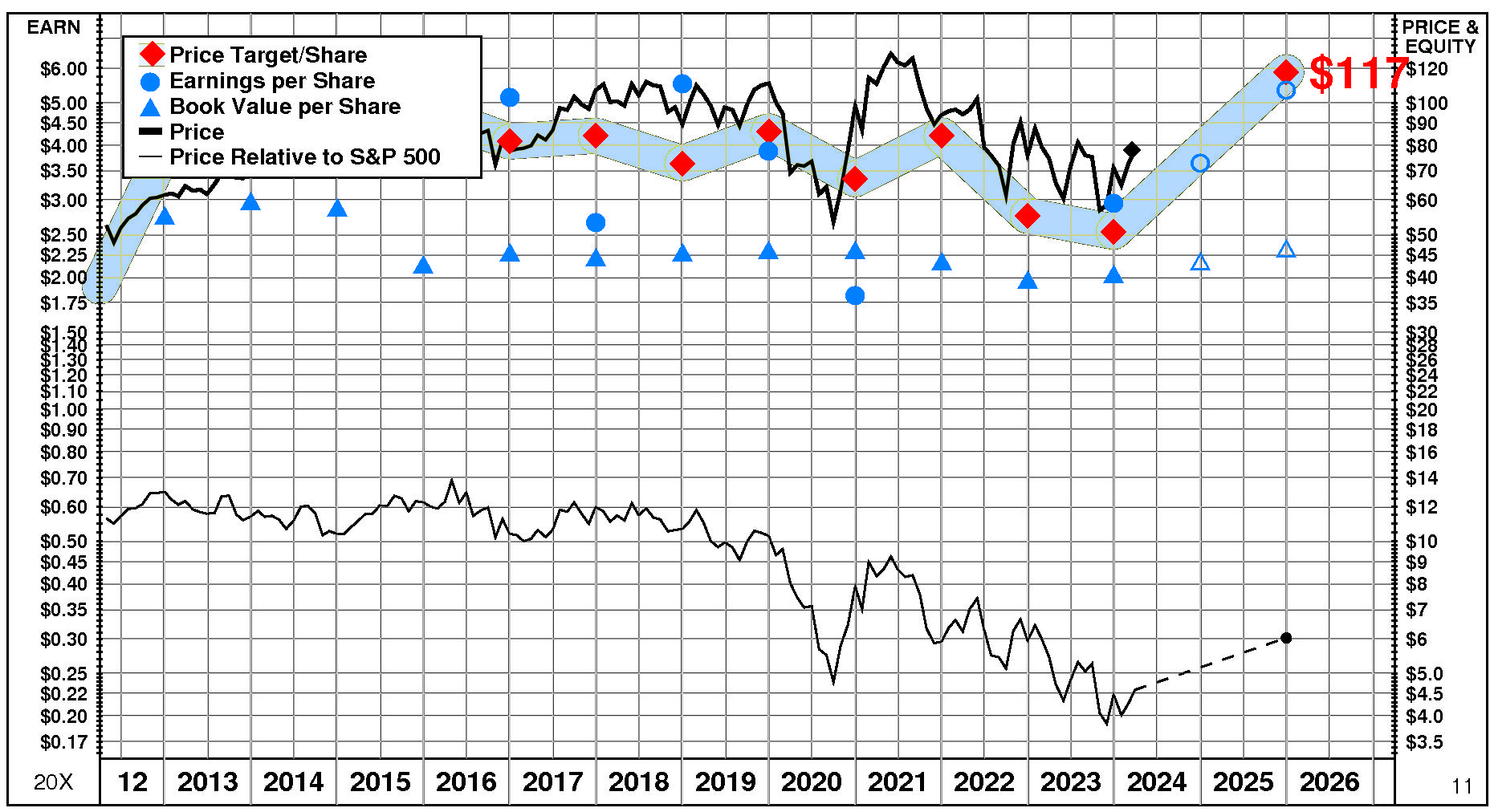
Kaiser Aluminum’s current Price Target is $117 (+131% from the 2023 Target of $51 and +50% from the 03/15/24 price of $78.30). This dramatic rise in the Target is the result of a +19% increase in the equity base and a +94% increase in the price/equity multiple. The forecasted increase in cost of equity has a very large negative impact on the price/equity multiple and the forecasted decline in growth has a slight negative impact as well. More than offsetting these Drivers, the forecasted increase in return on equity has a huge positive impact.
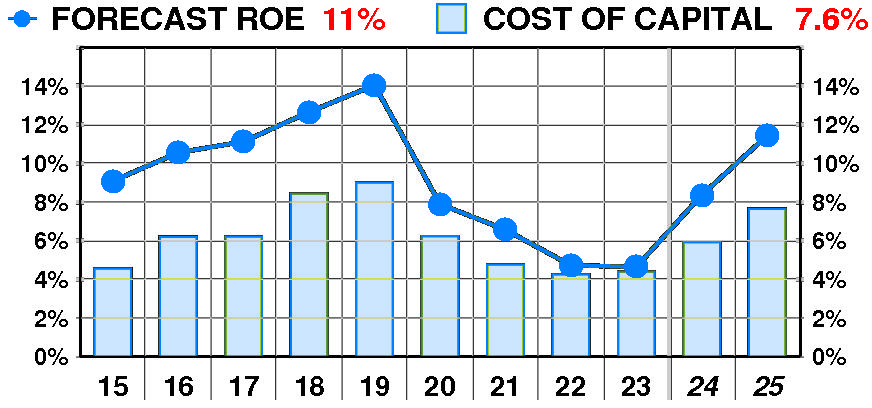
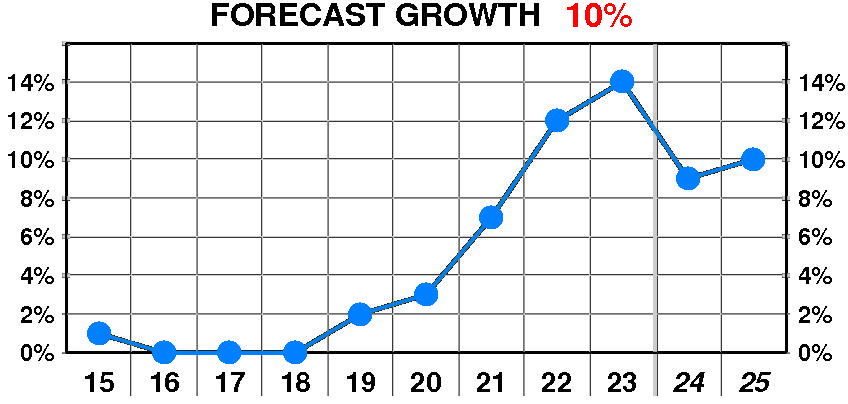
PTR’s return on equity forecast is 11.4% — above our recent forecasts. Forecasted return on equity suffered a dramatic, erratic decline between 2015 and 2023. The current forecast is below the 2019 peak of 14%.
PTR’s growth forecast is 10.0% — substantially above our recent forecasts. Forecasted growth enjoyed a dramatic, steady increase between 2015 and 2023. The current forecast is significantly above the 2018 low of 0%.
PTR’s cost of equity forecast is 7.6% — slightly above recent levels. Forecasted cost of equity enjoyed a dramatic, erratic decline between 2015 and 2023. The current forecast is above the 2015 low of 4.6%.
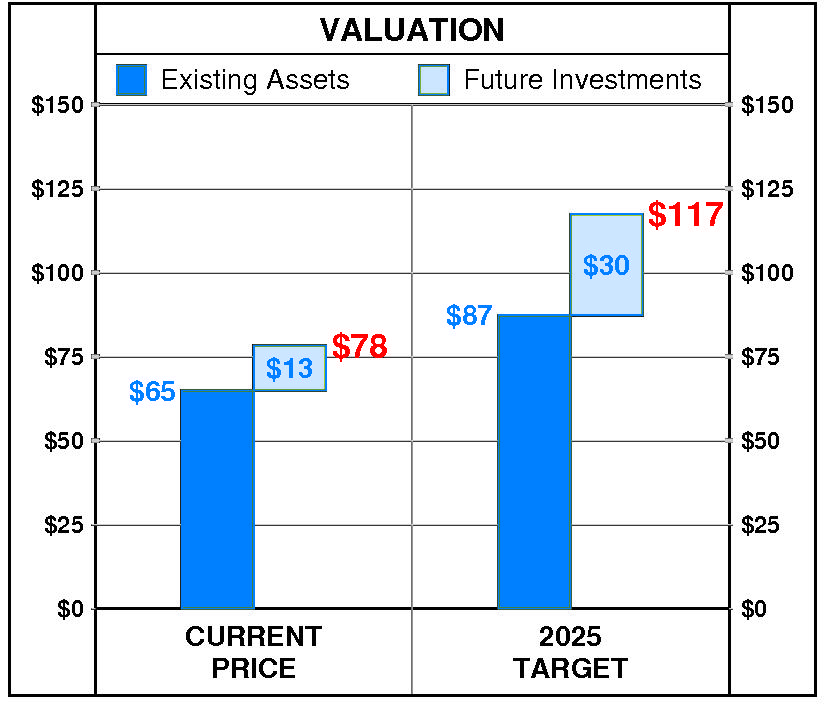
At Kaiser Aluminum’s current price of $78.30, investors are placing a positive value of $13 on its future investments. This view is consistent with the company’s most recent performance that reflected a growth rate of 14.0% per year, and a return on equity of 4.6% versus a cost of equity of 4.4%.
PTR’s 2025 Price Target of $117 is based on these forecasts and reflects an estimated value of existing assets of $87 and a value of future investments of $30.

Be the first to comment